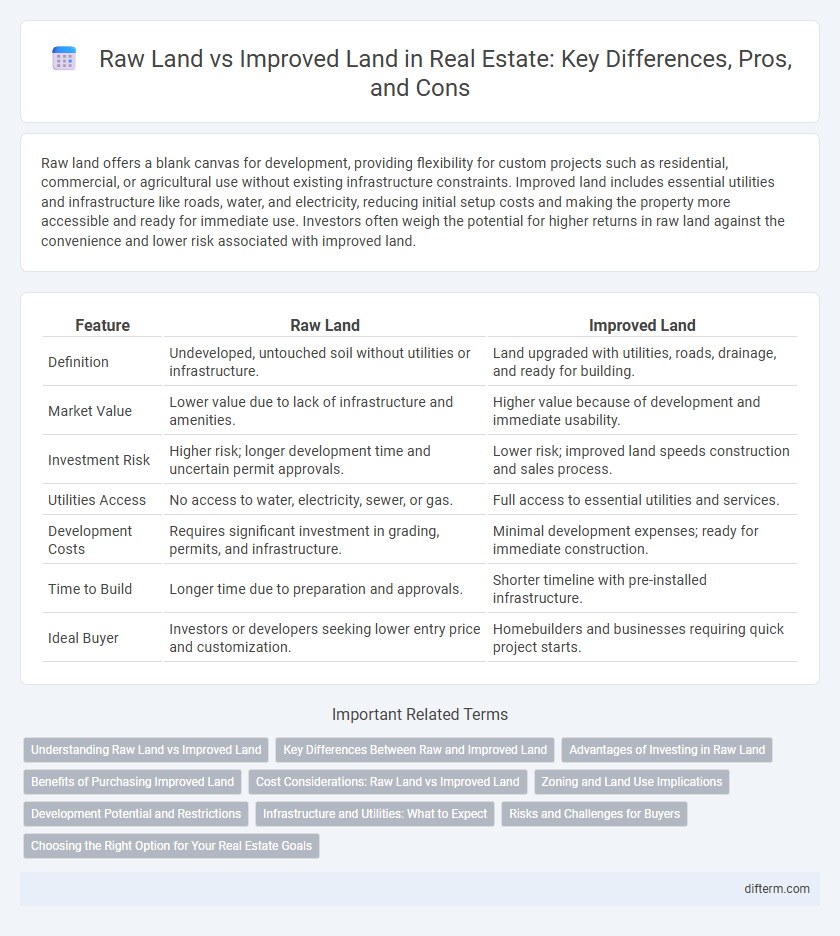Raw land offers a blank canvas for development, providing flexibility for custom projects such as residential, commercial, or agricultural use without existing infrastructure constraints. Improved land includes essential utilities and infrastructure like roads, water, and electricity, reducing initial setup costs and making the property more accessible and ready for immediate use. Investors often weigh the potential for higher returns in raw land against the convenience and lower risk associated with improved land.
Table of Comparison
| Feature | Raw Land | Improved Land |
|---|---|---|
| Definition | Undeveloped, untouched soil without utilities or infrastructure. | Land upgraded with utilities, roads, drainage, and ready for building. |
| Market Value | Lower value due to lack of infrastructure and amenities. | Higher value because of development and immediate usability. |
| Investment Risk | Higher risk; longer development time and uncertain permit approvals. | Lower risk; improved land speeds construction and sales process. |
| Utilities Access | No access to water, electricity, sewer, or gas. | Full access to essential utilities and services. |
| Development Costs | Requires significant investment in grading, permits, and infrastructure. | Minimal development expenses; ready for immediate construction. |
| Time to Build | Longer time due to preparation and approvals. | Shorter timeline with pre-installed infrastructure. |
| Ideal Buyer | Investors or developers seeking lower entry price and customization. | Homebuilders and businesses requiring quick project starts. |
Understanding Raw Land vs Improved Land
Raw land refers to undeveloped property without infrastructure such as roads, utilities, or buildings, making it a blank slate for potential development but requiring significant investment to prepare. Improved land includes essential enhancements like paved access, water, electricity, and sewage systems, increasing its usability and market value. Investors and developers must assess zoning regulations, soil quality, and environmental constraints when comparing raw land and improved land to determine feasibility and cost efficiency.
Key Differences Between Raw and Improved Land
Raw land refers to undeveloped property without utilities, infrastructure, or buildings, characterized by natural terrain and minimal accessibility. Improved land includes essential enhancements such as paved roads, utility connections (water, electricity, sewage), and zoning approvals, increasing its immediate usability and market value. The key differences center on development status, cost implications, and potential for construction or resale.
Advantages of Investing in Raw Land
Investing in raw land offers significant advantages such as lower upfront costs and greater flexibility in development options compared to improved land. Raw land provides opportunities for customization to specific uses like residential, commercial, or agricultural projects without the constraints of existing structures or infrastructure. Investors can benefit from potential appreciation in value as surrounding areas develop and zoning regulations evolve, enhancing future profitability.
Benefits of Purchasing Improved Land
Purchasing improved land provides immediate access to essential infrastructure such as water, electricity, and paved roads, significantly reducing development time and costs. Improved land often enhances property value and marketability due to these ready-to-use features. Buyers benefit from streamlined permitting processes and greater potential for construction and resale.
Cost Considerations: Raw Land vs Improved Land
Raw land typically incurs lower upfront costs but often requires significant investment in utilities, grading, and permits before development, resulting in unpredictable expenses. Improved land includes essential infrastructure such as roads, water, and electricity, which increases initial purchase price but reduces development time and unforeseen costs. Evaluating total financial outlay for development and potential return on investment is crucial when choosing between raw and improved land in real estate projects.
Zoning and Land Use Implications
Zoning regulations play a crucial role in defining the permitted uses for raw land versus improved land, influencing development potential and investment value. Raw land often faces stricter zoning restrictions, requiring rezoning or permits before construction or commercial use, while improved land typically conforms to existing zoning categories with established infrastructure. Understanding local zoning codes and land use implications is essential for maximizing property utility and ensuring compliance with municipal planning requirements.
Development Potential and Restrictions
Raw land offers greater flexibility for development potential due to the absence of existing structures, allowing for custom site planning and infrastructure installation according to zoning regulations. Improved land already contains essential utilities and built infrastructure, which can accelerate project timelines but may impose limitations based on existing permits, easements, and zoning restrictions. Developers must evaluate local zoning laws, environmental regulations, and subdivision requirements to maximize the value and usability of both raw and improved land parcels.
Infrastructure and Utilities: What to Expect
Raw land typically lacks essential infrastructure such as paved roads, sewage systems, water supply, and electrical connections, requiring significant investment to make it build-ready. Improved land already includes critical utilities and infrastructure, reducing development time and costs while enhancing property value. Buyers should assess the availability and condition of infrastructure and utilities to accurately estimate the total project expenses and avoid unexpected challenges.
Risks and Challenges for Buyers
Raw land presents higher risks for buyers due to uncertain zoning regulations, lack of essential infrastructure like water and electricity, and potential environmental hazards requiring costly remediation. Improved land, while typically more expensive, offers reduced challenges through established utilities, legal access, and clear property boundaries, minimizing unexpected expenses and development delays. Buyers must thoroughly conduct due diligence, including land surveys and regulatory checks, to mitigate financial losses and project setbacks.
Choosing the Right Option for Your Real Estate Goals
Raw land offers flexibility for custom development and lower initial costs, ideal for investors aiming to build tailored properties or hold for long-term appreciation. Improved land includes essential infrastructure such as roads, utilities, and drainage, reducing preparation time and enabling quicker construction, which suits buyers seeking immediate development or resale opportunities. Assessing zoning regulations, intended use, budget, and timeline is crucial for selecting between raw and improved land to align with specific real estate goals.
raw land vs improved land Infographic

 difterm.com
difterm.com